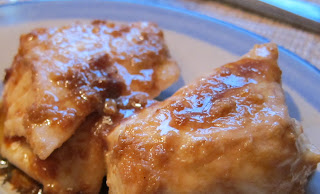Like everyone else, I take the microwave for granted. Sure, I use it to warm my soy milk for coffee every day, cook my oatmeal in the winter, heat leftovers for lunch or dinner and have the occasional cup of tea or bag of popcorn. But by-and-large, I think cooking in the microwave is somehow, how I shall put it . . . not really cooking. Maybe my microwave repertoire is just too limited?
However, I do think fish cooked in the microwave is fantastic!
Mostly I just pan fry salmon and other fish and use my snazzy grill pan for shrimp. But when I want to poach salmon or halibut, or just cook any fish exactly right, the microwave is perfect. About 1 ½ minutes on each side does the trick—sometimes that is even too long if the fillets are smallish. I let it rest for another minute or two. And the fish comes out perfectly flaky and done just to the point of tenderness.
A number of years ago I had some halibut cooked this way at the grocery store tasting station, cooked with a ginger-garlic-soy sauce marinade. That’s one of my favorite ways to cook halibut now. Since it’s just the two of us, buying halibut seems like a reasonable treat when it’s fresh and in season.
For two 7 oz. fillets:
In a glass baking pan, mix a 2 to 3 inch piece of fresh ginger with your microplane grater (you should really get one—they’re wonderful for zesting citrus too). Add two medium cloves of garlic (pressed with your garlic press), about ¼ cup of soy sauce and olive oil, and a few shakes of sesame oil. Turn the fish to coat and let it sit for an hour or so (or ½ hour if that’s all the time you have).
Cover the dish and microwave for 1 ½ minutes. Turn the fish and microwave on the other side. Test it with a fork to see if the fish flakes perfectly. If not, zap for another 30 seconds to one minute. To serve, spoon the marinade over the top if you would like. Last night we had roasted sweet potatoes, broccoli and a spinach salad with our halibut.







It's really nice to list all the ingredients and quantities separately in recipes (like almost all recipes do.) Makes for much easier reading and checking to see one has all the ingredients before starting out.
ReplyDeleteTry reading a recipe other than your own written in the style you've used above, if you can find one. It's not considerate for readers/cooks.
It's really nice to list all the ingredients and quantities separately in recipes (like almost all recipes do.) Makes for much easier reading and checking to see one has all the ingredients before starting out.
ReplyDeleteTry reading a recipe other than your own written in the style you've used above, if you can find one. It's not considerate for readers/cooks.